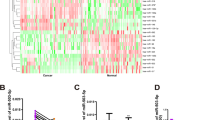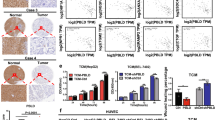Abstract
The previous studies in this lab discovered that microRNA-885-3p (miR-885-3p) was regulated by a sulfated polysaccharide that bound to bone morphogenetic protein receptor, type IA (BMPR1A) to inhibit angiogenesis. However, its specific role and its mechanism of action in tumor cells have not been elucidated. We show that miR-885-3p markedly suppresses angiogenesis in vitro and in vivo. MiR-885-3p inhibits Smad1/5/8 phosphorylation and downregulates DNA-binding protein inhibitor ID-1 (Id1), a proangiogenic factor, by targeting BMPR1A, leading to impaired angiogenesis. Overexpression or silencing of BMPR1A affects angiogenesis in a Smad/Id1-dependent manner. We further show that miR-885-3p impairs the growth of HT-29 colon cancer cell xenografts in nude mice by suppressing angiogenesis through disruption of BMPR1A and Smad/Id1 signaling. These results support a novel role for miR-885-3p in tumor angiogenesis by targeting BMPR1A, which regulates a proangiogenic factor, and provide new evidence that targeting miRNAs might be an effective therapeutic strategy for improving colon cancer treatment.
This is a preview of subscription content, access via your institution
Access options
Subscribe to this journal
Receive 50 print issues and online access
$259.00 per year
only $5.18 per issue
Buy this article
- Purchase on Springer Link
- Instant access to full article PDF
Prices may be subject to local taxes which are calculated during checkout








Similar content being viewed by others
References
Martello G, Rosato A, Ferrari F, Manfrin A, Cordenonsi M, Dupont S et al. A microrna targeting dicer for metastasis control. Cell 2010; 141: 1195–1207.
Lai EC . Micro RNAs are complementary to 3' UTR sequence motifs that mediate negative post-transcriptional regulation. Nat Genet 2002; 30: 363–364.
le Sage C, Nagel R, Egan DA, Schrier M, Mesman E, Mangiola A et al. Regulation of the p27(kip1) tumor suppressor by mir-221 and mir-222 promotes cancer cell proliferation. EMBO J 2007; 26: 3699–3708.
Suarez Y, Sessa WC . Micrornas as novel regulators of angiogenesis. Circ Res 2009; 104: 442–454.
Folkman J, Shing Y . Angiogenesis. J Biol Chem 1992; 267: 10931–10934.
Folkman J . Tumor angiogenesis: therapeutic implications. N Engl J Med 1971; 285: 1182–1186.
Perk J, Gil-Bazo I, Chin Y, de Candia P, Chen JJ, Zhao Y et al. Reassessment of id1 protein expression in human mammary, prostate, and bladder cancers using a monospecific rabbit monoclonal anti-id1 antibody. Cancer Res 2006; 66: 10870–10877.
Lyden D, Young AZ, Zagzag D, Yan W, Gerald W, O'Reilly R et al. Id1 and id3 are required for neurogenesis, angiogenesis and vascularization of tumour xenografts. Nature 1999; 401: 670–677.
Qiu H, Yang B, Pei ZC, Zhang Z, Ding K . Wss25 inhibits growth of xenografted hepatocellular cancer cells in nude mice by disrupting angiogenesis via blocking bone morphogenetic protein (bmp)/smad/id1 signaling. J Biol Chem 2010; 285: 32638–32646.
Miyazono K, Miyazawa K . Id: A target of bmp signaling. Sci STKE 2002; 2002: pe40.
Okamoto K, Ishiguro T, Midorikawa Y, Ohata H, Izumiya M, Tsuchiya N et al. Mir-493 induction during carcinogenesis blocks metastatic settlement of colon cancer cells in liver. EMBO J 2012; 31: 1752–1763.
Ventura A, Jacks T . Micrornas and cancer: short RNAs go a long way. Cell 2009; 136: 586–591.
Dong Y, Wu WK, Wu CW, Sung JJ, Yu J, Ng SS et al. Microrna dysregulation in colorectal cancer: a clinical perspective. Br J Cancer 2011; 104: 893–898.
Wu WK, Law PT, Lee CW, Cho CH, Fan D, Wu K et al. Microrna in colorectal cancer: from benchtop to bedside. Carcinogenesis 2011; 32: 247–253.
Valdimarsdottir G, Goumans MJ, Rosendahl A, Brugman M, Itoh S, Lebrin F et al. Stimulation of id1 expression by bone morphogenetic protein is sufficient and necessary for bone morphogenetic protein-induced activation of endothelial cells. Circulation 2002; 106: 2263–2270.
Kerbel RS . Tumor angiogenesis. N Engl J Med 2008; 358: 2039–2049.
Yamakuchi M, Lotterman CD, Bao C, Hruban RH, Karim B, Mendell JT et al. P53-induced microrna-107 inhibits hif-1 and tumor angiogenesis. Proc Natl Acad Sci USA 2010; 107: 6334–6339.
Cha ST, Chen PS, Johansson G, Chu CY, Wang MY, Jeng YM et al. Microrna-519c suppresses hypoxia-inducible factor-1alpha expression and tumor angiogenesis. Cancer Res 2010; 70: 2675–2685.
Guled M, Lahti L, Lindholm PM, Salmenkivi K, Bagwan I, Nicholson AG et al. Cdkn2a, nf2, and jun are dysregulated among other genes by mirnas in malignant mesothelioma—a miRNA microarray analysis. Gene Chromosomes Cancer 2009; 48: 615–623.
Huang Y, Chuang AY, Ratovitski EA . Phospho-deltanp63alpha/mir-885-3p axis in tumor cell life and cell death upon cisplatin exposure. Cell Cycle 2011; 10: 3938–3947.
Mishina Y, Starbuck MW, Gentile MA, Fukuda T, Kasparcova V, Seedor JG et al. Bone morphogenetic protein type ia receptor signaling regulates postnatal osteoblast function and bone remodeling. J Biol Chem 2004; 279: 27560–27566.
El-Bizri N, Wang L, Merklinger SL, Guignabert C, Desai T, Urashima T et al. Smooth muscle protein 22alpha-mediated patchy deletion of bmpr1a impairs cardiac contractility but protects against pulmonary vascular remodeling. Circ Res 2008; 102: 380–388.
Goulley J, Dahl U, Baeza N, Mishina Y, Edlund H . Bmp4-bmpr1a signaling in beta cells is required for and augments glucose-stimulated insulin secretion. Cell Metab 2007; 5: 207–219.
Zhou XP, Woodford-Richens K, Lehtonen R, Kurose K, Aldred M, Hampel H et al. Germline mutations in bmpr1a/alk3 cause a subset of cases of juvenile polyposis syndrome and of cowden and Bannayan–Riley–Ruvalcaba syndromes. Am J Hum Genet 2001; 69: 704–711.
van Hattem WA, Brosens LA, de Leng WW, Morsink FH, Lens S, Carvalho R et al. Large genomic deletions of smad4, bmpr1a and pten in juvenile polyposis. Gut 2008; 57: 623–627.
Xiao F, Qiu H, Zhou L, Shen X, Yang L, Ding K et al. Wss25 inhibits dicer, downregulating microrna-210, which targets ephrin-a3, to suppress human microvascular endothelial cell (hmec-1) tube formation. Glycobiology 2013; 23: 524–535.
Rubinson DA, Dillon CP, Kwiatkowski AV, Sievers C, Yang L, Kopinja J et al. A lentivirus-based system to functionally silence genes in primary mammalian cells, stem cells and transgenic mice by RNA interference. Nat Genet 2003; 33: 401–406.
Acknowledgements
This work was supported by grants from the National Natural Science Foundation of China (NSFC) (81171914, 31230022), the New Drug Creation and Manufacturing Program (2012ZX09301001-003) and the National Science Fund for Distinguished Young Scholars in China (81125025).
Author information
Authors and Affiliations
Corresponding author
Ethics declarations
Competing interests
The authors declare no conflict of interest.
Additional information
Supplementary Information accompanies this paper on the Oncogene website
Supplementary information
Rights and permissions
About this article
Cite this article
Xiao, F., Qiu, H., Cui, H. et al. MicroRNA-885-3p inhibits the growth of HT-29 colon cancer cell xenografts by disrupting angiogenesis via targeting BMPR1A and blocking BMP/Smad/Id1 signaling. Oncogene 34, 1968–1978 (2015). https://doi.org/10.1038/onc.2014.134
Received:
Revised:
Accepted:
Published:
Issue Date:
DOI: https://doi.org/10.1038/onc.2014.134
This article is cited by
-
Zebrafish xenograft as a tool for the study of colorectal cancer: a review
Cell Death & Disease (2024)
-
Recent developments on BMPs and their antagonists in inflammatory bowel diseases
Cell Death Discovery (2023)
-
circ_0061265 competitively binds to microRNA-885-3p to promote the development of gastric cancer by upregulating AURKA expression
Cancer Cell International (2022)
-
Exosomal miR-143-3p derived from follicular fluid promotes granulosa cell apoptosis by targeting BMPR1A in polycystic ovary syndrome
Scientific Reports (2022)
-
CircTUBGCP3 facilitates the tumorigenesis of lung adenocarcinoma by sponging miR-885-3p
Cancer Cell International (2021)



